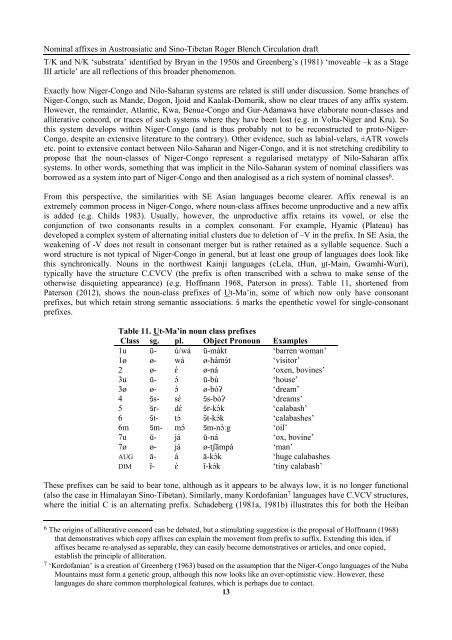The origins of nominal affixes in Austroasiatic and ... - Roger Blench
The origins of nominal affixes in Austroasiatic and ... - Roger Blench
The origins of nominal affixes in Austroasiatic and ... - Roger Blench
You also want an ePaper? Increase the reach of your titles
YUMPU automatically turns print PDFs into web optimized ePapers that Google loves.
Nom<strong>in</strong>al <strong>affixes</strong> <strong>in</strong> <strong>Austroasiatic</strong> <strong>and</strong> S<strong>in</strong>o-Tibetan <strong>Roger</strong> <strong>Blench</strong> Circulation draft<br />
T/K <strong>and</strong> N/K ‘substrata’ identified by Bryan <strong>in</strong> the 1950s <strong>and</strong> Greenberg’s (1981) ‘moveable –k as a Stage<br />
III article’ are all reflections <strong>of</strong> this broader phenomenon.<br />
Exactly how Niger-Congo <strong>and</strong> Nilo-Saharan systems are related is still under discussion. Some branches <strong>of</strong><br />
Niger-Congo, such as M<strong>and</strong>e, Dogon, Ijoid <strong>and</strong> Kaalak-Domurik, show no clear traces <strong>of</strong> any affix system.<br />
However, the rema<strong>in</strong>der, Atlantic, Kwa, Benue-Congo <strong>and</strong> Gur-Adamawa have elaborate noun-classes <strong>and</strong><br />
alliterative concord, or traces <strong>of</strong> such systems where they have been lost (e.g. <strong>in</strong> Volta-Niger <strong>and</strong> Kru). So<br />
this system develops with<strong>in</strong> Niger-Congo (<strong>and</strong> is thus probably not to be reconstructed to proto-Niger-<br />
Congo, despite an extensive literature to the contrary). Other evidence, such as labial-velars, ±ATR vowels<br />
etc. po<strong>in</strong>t to extensive contact between Nilo-Saharan <strong>and</strong> Niger-Congo, <strong>and</strong> it is not stretch<strong>in</strong>g credibility to<br />
propose that the noun-classes <strong>of</strong> Niger-Congo represent a regularised metatypy <strong>of</strong> Nilo-Saharan affix<br />
systems. In other words, someth<strong>in</strong>g that was implicit <strong>in</strong> the Nilo-Saharan system <strong>of</strong> <strong>nom<strong>in</strong>al</strong> classifiers was<br />
borrowed as a system <strong>in</strong>to part <strong>of</strong> Niger-Congo <strong>and</strong> then analogised as a rich system <strong>of</strong> <strong>nom<strong>in</strong>al</strong> classes 6 .<br />
From this perspective, the similarities with SE Asian languages become clearer. Affix renewal is an<br />
extremely common process <strong>in</strong> Niger-Congo, where noun-class <strong>affixes</strong> become unproductive <strong>and</strong> a new affix<br />
is added (e.g. Childs 1983). Usually, however, the unproductive affix reta<strong>in</strong>s its vowel, or else the<br />
conjunction <strong>of</strong> two consonants results <strong>in</strong> a complex consonant. For example, Hyamic (Plateau) has<br />
developed a complex system <strong>of</strong> alternat<strong>in</strong>g <strong>in</strong>itial clusters due to deletion <strong>of</strong> –V <strong>in</strong> the prefix. In SE Asia, the<br />
weaken<strong>in</strong>g <strong>of</strong> -V does not result <strong>in</strong> consonant merger but is rather reta<strong>in</strong>ed as a syllable sequence. Such a<br />
word structure is not typical <strong>of</strong> Niger-Congo <strong>in</strong> general, but at least one group <strong>of</strong> languages does look like<br />
this synchronically. Nouns <strong>in</strong> the northwest Ka<strong>in</strong>ji languages (cLela, tHun, ut-Ma<strong>in</strong>, Gwamhi-Wuri),<br />
typically have the structure C.CVCV (the prefix is <strong>of</strong>ten transcribed with a schwa to make sense <strong>of</strong> the<br />
otherwise disquiet<strong>in</strong>g appearance) (e.g. H<strong>of</strong>fmann 1968, Paterson <strong>in</strong> press). Table 11, shortened from<br />
Paterson (2012), shows the noun-class prefixes <strong>of</strong> Ut-Ma’<strong>in</strong>, some <strong>of</strong> which now only have consonant<br />
prefixes, but which reta<strong>in</strong> strong semantic associations. ɘ̄ marks the epenthetic vowel for s<strong>in</strong>gle-consonant<br />
prefixes.<br />
Table 11. Ut-Ma’<strong>in</strong> noun class prefixes<br />
Class sg. pl. Object Pronoun Examples<br />
1u ū- ú/wá ū-mákt ‘barren woman’<br />
1ø ø- wá ø-hámɘ̀t ‘visitor’<br />
2 ø- ɛ́ ø-ná ‘oxen, bov<strong>in</strong>es’<br />
3u ū- ɔ́ ū-bù ‘house’<br />
3ø ø- ɔ́ ø-bòʔ ‘dream’<br />
4 ɘ̄ s- sɛ́ ɘ̄ s-bòʔ ‘dreams’<br />
5 ɘ̄ r- dɛ́ ɘ̄ r-kɔ́k ‘calabash’<br />
6 ɘ̄ t- tɔ́ ɘ̄ t-kɔ́k ‘calabashes’<br />
6m ɘ̄ m- mɔ́ ɘ̄ m-nɔ̀ːg ‘oil’<br />
7u ū- já ū-ná ‘ox, bov<strong>in</strong>e’<br />
7ø ø- já ø-tʃāmpá ‘man’<br />
AUG ā- á ā-kɔ́k ‘huge calabashes<br />
DIM ī- ɛ́ ī-kɔ́k ‘t<strong>in</strong>y calabash’<br />
<strong>The</strong>se prefixes can be said to bear tone, although as it appears to be always low, it is no longer functional<br />
(also the case <strong>in</strong> Himalayan S<strong>in</strong>o-Tibetan). Similarly, many Kord<strong>of</strong>anian 7 languages have C.VCV structures,<br />
where the <strong>in</strong>itial C is an alternat<strong>in</strong>g prefix. Schadeberg (1981a, 1981b) illustrates this for both the Heiban<br />
6 <strong>The</strong> <strong>orig<strong>in</strong>s</strong> <strong>of</strong> alliterative concord can be debated, but a stimulat<strong>in</strong>g suggestion is the proposal <strong>of</strong> H<strong>of</strong>fmann (1968)<br />
that demonstratives which copy <strong>affixes</strong> can expla<strong>in</strong> the movement from prefix to suffix. Extend<strong>in</strong>g this idea, if<br />
<strong>affixes</strong> became re-analysed as separable, they can easily become demonstratives or articles, <strong>and</strong> once copied,<br />
establish the pr<strong>in</strong>ciple <strong>of</strong> alliteration.<br />
7 ‘Kord<strong>of</strong>anian’ is a creation <strong>of</strong> Greenberg (1963) based on the assumption that the Niger-Congo languages <strong>of</strong> the Nuba<br />
Mounta<strong>in</strong>s must form a genetic group, although this now looks like an over-optimistic view. However, these<br />
languages do share common morphological features, which is perhaps due to contact.<br />
13
















